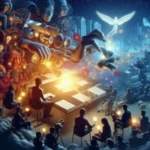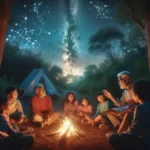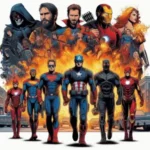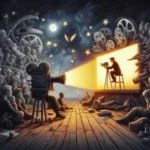Throughout the annals of history, storytelling has served as a vital thread connecting cultures, generations, and civilizations.
From the ancient epics of Gilgamesh and the Iliad to the enchanting folktales passed down through oral tradition, these timeless tales encapsulate the human experience in all its complexity—love, betrayal, heroism, and sacrifice. They transcend the boundaries of time and geography, inviting us to explore the rich tapestry of human emotions and shared wisdom. In this blog post, we will journey through some of the most epic stories that have stood the test of time, examining their origins, themes, and the profound impact they continue to have on our understanding of ourselves and the world around us. Join us as we delve into these magnificent narratives that inspire, teach, and unite us across generations and civilizations, reminding us of our shared humanity in an ever-changing world.
1. Introduction to Timeless Tales
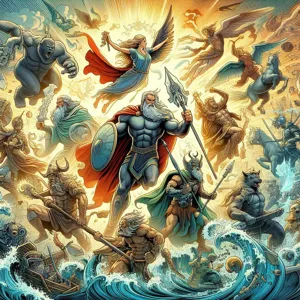
In a world bustling with fleeting trends and ephemeral content, there exists a realm of storytelling that transcends the boundaries of time and culture—these are the timeless tales. From ancient epics woven into the fabric of our earliest civilizations to modern retellings that capture the essence of human experience, these narratives have a unique power to resonate across generations. They serve as mirrors reflecting our innermost fears, aspirations, and moral dilemmas, connecting us to our ancestors and to each other in profound ways.
Imagine the grand halls of ancient Greece, where bards recited the epic sagas of heroes like Achilles and Odysseus, their verses echoing through time. Picture the rich oral traditions of Indigenous peoples, who, through the art of storytelling, preserve the wisdom of their ancestors and the natural world around them. Each tale, whether it be the tragic love story of Romeo and Juliet, the heroic journeys found in the Mahabharata, or the enchanting fables of Aesop, carries with it the weight of cultural significance and timeless truths.
As we embark on this journey through the pages of history and storytelling, we will explore the epic tales that have stood the test of time, delving into their origins, themes, and the enduring lessons they impart. Join us as we uncover the magic of these narratives that, despite their diverse backgrounds and contexts, unite us in our shared humanity, reminding us that the stories we tell are as vital to our existence as the air we breathe. Through these timeless tales, we not only celebrate our past but also illuminate the path forward, fostering connections that bridge the gaps between generations and civilizations.
2. The Universal Themes of Epic Stories
Epic stories have a unique ability to resonate across cultures and eras, and at the heart of this resonance lie universal themes that bind us all together. These narratives often explore the fundamental aspects of the human experience, such as love, loss, honor, and the quest for identity. They delve into the complexities of good versus evil, the struggle for power, and the pursuit of knowledge, reflecting the very essence of what it means to be human.
Take, for instance, the theme of heroism. From the ancient tales of Gilgamesh to the modern saga of Harry Potter, heroes emerge as individuals who confront insurmountable challenges, embodying the courage and resilience that inspire audiences of all ages. These characters often grapple with their own flaws and fears, making their journeys relatable and poignant. Through their struggles, we see echoes of our own challenges and triumphs, reminding us that courage can be found even in the most unlikely of circumstances.
Another compelling theme is the exploration of fate versus free will. In epics like the Iliad, characters are often caught in the machinations of gods and destiny, yet they still make choices that define their paths. This tension invites readers to ponder their own lives: to what extent are we the architects of our destiny, and how much is dictated by forces beyond our control? Such questions resonate deeply, transcending time and culture, as audiences grapple with the complexities of their own existence.
Additionally, love—whether it be romantic, familial, or platonic—serves as a powerful theme that weaves through epic narratives. From the tragic love of Orpheus and Eurydice to the unwavering bonds of friendship in The Lord of the Rings, these stories highlight love’s transformative power, illustrating how it can motivate individuals to achieve greatness or lead to their ultimate downfall. Through these explorations, we are reminded of love’s dual capacity for joy and sorrow, making it a timeless topic of human connection.
Ultimately, the universal themes found in epic stories serve as a mirror reflecting our collective experiences. They explore the depths of our emotions, the intricacies of our relationships, and the eternal questions that haunt humanity. As new generations encounter these tales, they find not just entertainment but also a profound understanding of themselves and the world around them, ensuring that these stories remain relevant across time and civilization.
3. The Role of Oral Tradition in Storytelling
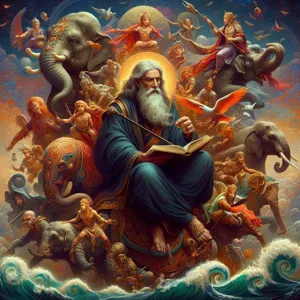
Oral tradition has long been the lifeblood of storytelling, serving as a vibrant thread that weaves together generations and civilizations. Before the written word graced the pages of history, tales were passed down through the spoken word, carried on the breath of storytellers who captivated audiences with their vivid imaginations and dramatic flair. This mode of transmission not only preserved the narratives but also infused them with a unique rhythm and energy that brought characters and events to life in the minds of listeners.
In many cultures, oral traditions acted as a communal experience, transforming storytelling into a ritualistic event. Families and friends would gather around flickering fires or under starlit skies, eagerly awaiting the unfolding of tales that held lessons, morals, and the essence of their shared identity. These stories often featured heroic figures, mythical creatures, and moral dilemmas that resonated deeply with the human experience, allowing individuals from disparate backgrounds to find common ground in universal themes of love, courage, and the struggle between good and evil.
Moreover, oral tradition is inherently adaptable. Each retelling allows for nuances to emerge, reflecting the values and beliefs of the current audience. This adaptability is a testament to the living nature of these stories; they are not static relics but dynamic narratives that evolve with each generation. As they traverse time and space, oral stories maintain relevance by incorporating contemporary issues, ensuring that they continue to resonate with the hearts and minds of listeners.
In today’s fast-paced world, the importance of oral tradition is often overshadowed by digital media. However, its impact can still be felt. Podcasts, storytelling events, and even social media platforms have revived the art of storytelling, echoing the age-old practice of sharing experiences and lessons through the spoken word. By recognizing the role of oral tradition in storytelling, we not only honor our ancestors but also empower ourselves to engage with narratives that transcend the limitations of time, fostering connections that bind us across cultures and generations.
4. Epic Stories from Ancient Civilizations
Epic stories from ancient civilizations have the remarkable ability to transcend time and culture, weaving together the threads of human experience into narratives that resonate with audiences even today. These tales, often steeped in mythology and rich symbolism, reflect the values, fears, and aspirations of the societies from which they emerged.
Take, for instance, the **Epic of Gilgamesh**, one of the oldest known works of literature, originating from ancient Mesopotamia. This epic poem chronicles the adventures of Gilgamesh, a historical king of Uruk, as he embarks on a quest for immortality. Through his encounters with gods, monsters, and the wild man Enkidu, the story explores profound themes of friendship, mortality, and the human condition. The poignant quest for eternal life serves as a reminder of our shared struggles against the inevitable passage of time.
Similarly, the **Iliad** and the **Odyssey**, attributed to the ancient Greek poet Homer, have captivated readers for centuries. The **Iliad** recounts the events of the Trojan War, emphasizing themes of honor, pride, and the capricious nature of the gods. The **Odyssey**, on the other hand, follows the hero Odysseus as he navigates treacherous seas and encounters mythical beings on his journey home. These tales not only provide thrilling adventures but also offer insights into the moral complexities of human life and the importance of loyalty and perseverance.
From the **Mahabharata** of India, with its intricate blend of philosophy and epic battles, to the **Aeneid** of Rome, which tells the story of Aeneas’s journey from the ruins of Troy to the founding of Rome, these ancient narratives continue to shape our understanding of heroism, sacrifice, and the interconnectedness of humanity.
As we delve into the epic stories of ancient civilizations, we uncover the timeless lessons they impart, reminding us that while societies may change, the core human experiences they address remain remarkably consistent across the ages. These tales not only enrich our cultural heritage but also invite us to reflect on our own lives, connecting us to the past as we navigate the future.
5. The Influence of Mythology on Modern Narratives
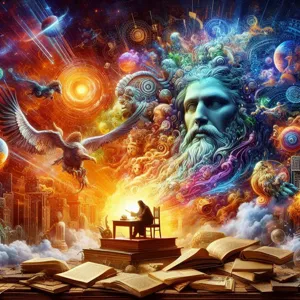
Mythology has long served as the backbone of storytelling across cultures, providing a treasure trove of archetypes, themes, and moral lessons that continue to resonate in modern narratives. The tales of gods and heroes, filled with grandeur and tragedy, have shaped our understanding of human experience, weaving intricate tapestries that explore the complexities of life, love, and morality. From the epic sagas of ancient Greece to the vibrant folklore of indigenous cultures, these age-old myths have a remarkable way of transcending time, influencing contemporary literature, film, and art in profound ways.
Take, for instance, the archetype of the hero’s journey, prominently featured in Joseph Campbell’s work and echoed in countless modern stories. Characters like Luke Skywalker in “Star Wars” and Katniss Everdeen in “The Hunger Games” exemplify this narrative structure, embarking on transformative quests that reflect the struggles and triumphs of their mythological predecessors. The themes of sacrifice, redemption, and the eternal battle between good and evil, derived from mythological sources, continue to captivate audiences and provide a framework for understanding our own lives.
Moreover, mythology often serves as a cultural touchstone, allowing us to explore our identities and values. As modern storytellers draw upon these ancient narratives, they reinterpret and recontextualize them to address contemporary issues, such as gender roles, environmental concerns, and societal conflicts. For example, the reinterpretation of figures like Medusa in recent literature and film challenges traditional narratives, giving voice to marginalized characters and reflecting the evolving landscape of gender politics.
The influence of mythology extends beyond literature and film; it permeates marketing, pop culture, and even everyday language. Phrases derived from mythological stories, such as “Achilles’ heel” or “Pandora’s box,” have become ingrained in our vocabulary, illustrating how deeply these ancient tales have infiltrated our consciousness. As we navigate an increasingly complex world, the timeless wisdom found in these narratives offers guidance, reminding us of the shared human experiences that connect us across generations and civilizations.
In essence, the influence of mythology on modern narratives is a testament to the enduring power of storytelling. These ancient tales not only entertain but also enlighten, providing a rich reservoir of wisdom that continues to inspire and shape our collective imagination. As we delve into the epic stories that span the ages, we discover that the threads of mythology remain intricately woven into the fabric of our contemporary existence, guiding us as we craft our own narratives in the ever-evolving story of humanity.
6. Notable Timeless Tales Across Cultures
Stories have the unique power to transcend time and space, weaving intricate tapestries of human experience that resonate across cultures and generations. Here, we explore a selection of notable timeless tales that have stood the test of time, showcasing the universal themes of love, bravery, and the quest for knowledge that connect us all.
**The Epic of Gilgamesh**: Hailing from ancient Mesopotamia, this epic poem is often regarded as one of the earliest works of literature. It chronicles the adventures of Gilgamesh, a king who embarks on a quest for immortality after the death of his friend Enkidu. Through trials that test his strength and wisdom, Gilgamesh ultimately learns that true immortality lies in the legacy one leaves behind. The tale speaks to the human condition, exploring themes of friendship, loss, and the pursuit of meaning.
**The Mahabharata**: This colossal Indian epic is not only a story of an epic war between two families but also a treasure trove of philosophical and moral lessons. At its heart lies the Bhagavad Gita, a dialogue between Prince Arjuna and Lord Krishna that addresses the dilemmas of duty, righteousness, and the nature of reality. The Mahabharata’s rich tapestry of characters and events serves as a reflection of the complexities of human nature and the moral intricacies of life.
**The Tale of Genji**: Often considered the world’s first novel, this classic Japanese work follows the life of Hikaru Genji, a nobleman known for his romantic liaisons and poetic sensibilities. Written by Murasaki Shikibu in the early 11th century, it delves into the intricacies of court life, love, and the passage of time. The Tale of Genji not only offers a glimpse into the aesthetics and culture of the Heian period but also captures the fleeting nature of beauty and human emotion.
**Cinderella**: This beloved fairy tale has countless variations across cultures, each reflecting the values and norms of the society from which it originates. From the European version of Cinderella, featuring a fairy godmother and glass slippers, to the Chinese tale of Ye Xian, where a magical fish provides aid, the essence of the story remains the same: the triumph of kindness and virtue over cruelty and adversity. This universal theme of hope and transformation continues to resonate with audiences of all ages.
**The Odyssey**: This ancient Greek epic, attributed to Homer, narrates the long and perilous journey of Odysseus as he strives to return home after the Trojan War. Filled with encounters with gods, monsters, and enchanting beings, The Odyssey explores themes of heroism, loyalty, and the enduring power of homecoming. Its influence can be seen in countless retellings and adaptations, underscoring the timeless appeal of the hero’s journey.
These tales, rich in cultural significance and moral lessons, remind us of the threads that bind humanity together. They capture the essence of our shared dreams, fears, and aspirations, proving that no matter where we come from, we are all part of the same narrative tapestry. As we delve into these timeless stories, we not only celebrate their historical importance but also find reflections of our own lives within their pages.
7. The Hero’s Journey: A Common Thread

The Hero’s Journey is a narrative framework that transcends cultures and epochs, serving as a universal blueprint for storytelling. This timeless structure, first articulated by Joseph Campbell in his seminal work, “The Hero with a Thousand Faces,” reveals the profound similarities found in myths, legends, and epics from around the globe. Whether it’s the epic quests of ancient heroes or the modern-day struggles of everyday individuals, the Hero’s Journey encapsulates the trials, transformations, and triumphs that resonate deeply within the human experience.
At its core, the Hero’s Journey follows a series of stages that any protagonist must navigate: from the call to adventure and the initial refusal, to the eventual crossing of thresholds into unknown realms. Along the way, heroes encounter mentors, face formidable adversaries, and confront their own inner demons. These elements craft a compelling narrative that not only captivates audiences but also mirrors the challenges and growth individuals face in their own lives.
Consider the journey of Odysseus in Homer’s “The Odyssey,” who faces treacherous seas, mythical creatures, and his own hubris on his quest to return home. Similarly, in J.R.R. Tolkien’s “The Lord of the Rings,” Frodo Baggins embarks on an epic adventure filled with peril and self-discovery, ultimately revealing the strength that lies within even the most unlikely of heroes. Across different civilizations and eras, we find figures like King Arthur, Beowulf, and Harry Potter, each embodying the heroic archetype and reinforcing the notion that the journey toward self-discovery and resilience is a fundamental part of the human condition.
As we explore these timeless tales, we uncover not just the stories themselves, but the shared values and lessons they impart. The Hero’s Journey teaches us about courage, sacrifice, and the importance of community, reminding us that, no matter the era or the backdrop, the essence of what it means to be human remains unchanged. It is this common thread, woven into the fabric of our collective narratives, that continues to inspire and connect us across generations and civilizations.
8. The Evolution of Storytelling Techniques
The art of storytelling has undergone a remarkable transformation over the centuries, evolving alongside humanity’s journey through time and culture. From the oral traditions of ancient tribes gathering around flickering fires to the sophisticated digital narratives we consume today, the techniques and mediums of storytelling have continually adapted to reflect the changing landscapes of society.
In the early days, stories were woven into the fabric of everyday life, often serving dual purposes: to entertain and to educate. Oral storytelling relied heavily on rhythm, repetition, and vivid imagery, allowing storytellers to captivate their audiences and instill moral lessons that would be passed down through generations. These tales often mirrored the values and beliefs of their societies, reinforcing communal identities and cultural heritage.
As civilizations grew and writing systems developed, storytelling began to shift from the oral to the written word. Ancient texts like the Epic of Gilgamesh and Homer’s Iliad showcased a more structured narrative form, allowing for complex character development and intricate plots. This evolution opened new avenues for storytelling, enabling authors to explore themes of heroism, love, and morality across vast landscapes and historical contexts.
With the advent of the printing press in the 15th century, storytelling entered a new era. Books became accessible to the masses, leading to a flourishing of literature during the Renaissance and beyond. The rise of novels and short stories in the 18th and 19th centuries introduced readers to diverse voices and perspectives, further enriching the tapestry of human experience.
In the 20th century, the inclusion of new media such as film, television, and eventually the internet revolutionized storytelling once again. Visual and auditory elements allowed for immersive experiences that engaged audiences in unprecedented ways. As a result, stories could now be told not just through words, but through images, sound, and interactivity, creating a multi-sensory experience that transcended the limitations of traditional formats.
Today, we witness the fusion of storytelling techniques across platforms. Social media, podcasts, and interactive video games have transformed how stories are told and consumed, blurring the lines between author and audience. These modern narratives often emphasize participation and engagement, inviting audiences to become co-creators in the storytelling process.
As we reflect on the evolution of storytelling techniques, it is clear that while the methods may change, the core purpose remains the same: to connect, to inspire, and to share the human experience. Whether through ancient epics or contemporary digital narratives, the timeless art of storytelling continues to thrive, bridging gaps between generations and civilizations, reminding us of our shared humanity.
9. Impact of Timeless Tales on Literature and Film
The impact of timeless tales on literature and film is profound, serving as the bedrock upon which countless narratives are built. These stories, often steeped in universal themes of love, conflict, heroism, and morality, resonate with audiences across generations and cultures, providing a common thread that binds us together. From ancient epics like Homer’s *Iliad* and *Odyssey* to modern cinematic masterpieces like *The Lord of the Rings*, these narratives have shaped our storytelling methods, character archetypes, and thematic explorations.
In literature, timeless tales inspire authors to explore new dimensions of age-old themes, allowing for reinterpretation and innovation. Take, for instance, the retellings of classic fairy tales. Works like Angela Carter’s *The Bloody Chamber* and Gregory Maguire’s *Wicked* breathe new life into well-known stories, offering fresh perspectives and deeper character explorations. These adaptations not only pay homage to their origins but also challenge the reader’s understanding of good and evil, and the complexities of human nature.
Similarly, in film, the influence of these epic stories is undeniable. Many successful films borrow narrative structures or character arcs from timeless tales, creating a familiarity that draws viewers in. The hero’s journey, for example, as defined by Joseph Campbell in *The Hero with a Thousand Faces*, is a template that has been utilized in countless movies, from *Star Wars* to *The Lion King*. This archetypal journey allows audiences to connect with characters on a deeper level, as they witness familiar struggles and triumphs played out on the screen.
Moreover, the visual medium of film amplifies the emotional impact of these tales through cinematic techniques—stunning visuals, powerful scores, and captivating performances. The epic battles of *The Odyssey* or the moral dilemmas faced by characters in Shakespearean dramas are brought to life in ways that evoke visceral responses from the audience, ensuring that these stories remain relevant and engaging.
Ultimately, the interplay between timeless tales and contemporary storytelling—whether in literature or film—creates a rich tapestry of narrative that transcends time and space. As new generations discover these stories, they continue to inspire and shape the cultural landscape, proving that the essence of a great tale is indeed eternal, echoing across the ages and inviting us to reflect on the human experience.
10. Lessons Learned from Epic Stories
Epic stories have a unique ability to transcend time and culture, offering invaluable lessons that resonate across generations. From ancient mythologies to modern-day sagas, these narratives encapsulate the essence of the human experience, revealing truths about our nature, our relationships, and our place in the world.
One of the most powerful lessons derived from these tales is the importance of resilience. Characters such as Odysseus in Homer’s “The Odyssey” and Gilgamesh in the Mesopotamian epic remind us that life is a journey filled with trials and tribulations. Their perseverance through adversity teaches us that setbacks are not the end, but rather stepping stones on the path to growth and self-discovery.
Another vital lesson is the value of community and companionship. In stories like “The Ramayana,” the bonds of friendship and loyalty are critical to overcoming formidable challenges. These narratives emphasize that while individual strength is essential, it is often the support of others that leads to true triumph. The importance of collaboration and shared purpose resonates deeply in our interconnected world today.
Moreover, epic tales often explore the complexities of morality and the consequences of our choices. Characters are frequently faced with ethical dilemmas that force them to confront their values and the impact of their actions on others. These narratives encourage critical thinking and self-reflection, reminding us that our decisions shape not only our own lives but also the lives of those around us.
Lastly, the theme of identity and self-discovery is prevalent in many epic stories. As protagonists embark on their quests, they often grapple with questions of who they are and what they stand for. This journey of self-exploration is an integral part of the human experience, inviting readers to reflect on their own identities and the legacies they wish to leave behind.
In essence, the lessons learned from epic stories are timeless, serving as guides to navigate the complexities of life. They remind us to be resilient in the face of challenges, to cherish our relationships, to consider the moral implications of our choices, and to embark on our own journeys of self-discovery. By embracing these lessons, we can cultivate a deeper understanding of ourselves and the world, ensuring that the wisdom of the past continues to illuminate our paths for generations to come.
11. How Timeless Tales Shape Cultural Identity
Timeless tales are more than just stories; they are the very fabric of cultural identity, weaving together the values, beliefs, and histories of civilizations across generations. These narratives, whether shared around a crackling fire or transmitted through the pages of a book, possess the unique ability to reflect the intricacies of human experience. They carry the lessons learned by ancestors, encapsulate collective wisdom, and shape the moral compasses of societies.
From the ancient epics like the *Iliad* and the *Mahabharata* to modern classics such as *To Kill a Mockingbird*, these stories serve as mirrors, reflecting the struggles and triumphs of their times. They often address universal themes—love, loss, courage, and the quest for identity—that resonate deeply across diverse cultures. As people engage with these narratives, they find common ground, fostering a sense of belonging and continuity within their communities.
Moreover, timeless tales often reinforce cultural rituals and traditions, acting as a bridge between the past and present. Festivals, ceremonies, and storytelling gatherings are often inspired by these narratives, creating communal experiences that not only celebrate shared heritage but also invite younger generations to participate in the ongoing dialogue of identity formation.
In this way, storytelling becomes an act of preservation, ensuring that the essence of a culture is not lost to time. As these tales are passed down through storytelling, writing, and now digital mediums, they evolve, adapting to new contexts while still maintaining their core messages. Ultimately, timeless tales not only shape cultural identity but also foster empathy and understanding among different peoples, reminding us that despite our diverse backgrounds, the human experience connects us all.
12. The Relevance of Timeless Tales in Today’s Society
In an age defined by rapid technological advancements and ever-changing cultural landscapes, timeless tales continue to resonate deeply with audiences across generations. These narratives, often rooted in universal themes of love, loss, heroism, and morality, serve as a mirror reflecting our own experiences and challenges. They remind us of our shared humanity, transcending the boundaries of time, geography, and societal norms.
Take, for instance, the enduring appeal of ancient epics like *The Iliad* and *The Odyssey*. These stories, born in a world vastly different from our own, still capture the complexities of human emotion and conflict. They explore the heroic journey, the consequences of pride, and the quest for identity—questions that remain pertinent even as we navigate the complexities of modern life. In a world inundated with information, these narratives offer a reprieve, inviting us to pause and reflect on the age-old dilemmas that define the human condition.
Moreover, timeless tales serve as powerful educational tools. They enrich our understanding of historical contexts while fostering critical thinking and empathy. By engaging with these stories, individuals can explore diverse perspectives and cultures, gaining insights that are crucial in our increasingly interconnected world. The moral lessons embedded in these narratives also provide a framework for ethical considerations, guiding us in our personal and communal lives.
In today’s society, where distractions are ubiquitous and attention spans are fleeting, the relevance of timeless tales is more pronounced than ever. They not only entertain but also prompt us to ask essential questions about our values, relationships, and the legacies we wish to leave behind. As we gather around stories—whether through books, films, or oral traditions—we participate in a collective experience that unites us. In this way, timeless tales do more than endure; they thrive, reminding us that the stories we tell and share are an integral part of what it means to be human.
13. Adapting Epic Stories for Contemporary Audiences
Adapting epic stories for contemporary audiences is both an art and a science, requiring a deep understanding of the original narrative while simultaneously engaging with the values, challenges, and sensibilities of today’s society. These timeless tales—rich in archetypes, moral dilemmas, and cultural significance—possess a universal appeal that can resonate across ages. Yet, to breathe new life into these ancient narratives, creators must carefully navigate the evolving landscape of cultural relevance.
Take, for instance, the epic of Gilgamesh, one of the oldest known stories. While its themes of friendship, mortality, and the quest for meaning remain profoundly relevant, modern adaptations might focus on the emotional journey of Gilgamesh, showcasing his vulnerabilities and personal growth in ways that speak to today’s audience. By incorporating contemporary issues such as mental health, leadership ethics, and the quest for identity, the narrative becomes relatable to current generations, who may find their own struggles reflected in Gilgamesh’s journey.
Furthermore, the medium of storytelling has evolved dramatically, offering fresh avenues for adaptation. From films and graphic novels to podcasts and interactive video games, the possibilities are endless. Each medium provides unique opportunities to explore character depth and thematic complexity. For instance, a graphic novel adaptation of Homer’s “The Odyssey” could emphasize visual storytelling, bringing the fantastical elements of Odysseus’s journey to life through vibrant illustrations that capture the imagination of younger audiences.
Importantly, cultural sensitivity plays a crucial role in adapting these stories. Respecting the origins and meanings behind epic tales while infusing them with modern perspectives requires a delicate balance. Engaging diverse voices in the adaptation process not only enriches the narrative but also ensures that it resonates authentically with a broader audience.
Ultimately, the goal of adapting epic stories for contemporary audiences is not merely to retell them but to reinvent them, allowing these age-old narratives to evolve and thrive in the modern context. By doing so, they continue to inspire and captivate generations, proving that, though the world may change, the core human experiences depicted in these tales remain timeless.
14. Resources for Exploring Timeless Tales
When embarking on a journey through the rich tapestry of timeless tales, it’s beneficial to have a well-curated set of resources at your disposal. These treasures not only provide access to the stories themselves but also deepen your understanding of their cultural significance and historical context. Here’s a selection of resources that can guide you through the vast landscape of epic narratives.
**Books and Anthologies:** Start with classic collections that serve as gateways to timeless narratives. Texts like “The Epic of Gilgamesh,” “The Iliad,” and “The Mahabharata” are foundational works that offer insights into the values and beliefs of ancient civilizations. Additionally, anthologies such as “The World’s Greatest Stories” or “Mythology” by Edith Hamilton compile various tales that span cultures and time periods, allowing readers to appreciate the similarities and differences in storytelling across the globe.
**Online Courses and Lectures:** Platforms like Coursera, edX, and The Great Courses offer online classes that delve into the themes, characters, and historical contexts of timeless tales. Engaging with lectures from esteemed scholars can enhance your understanding and spark new reflections on these age-old narratives.
**Podcasts:** The rise of storytelling podcasts has made it easier than ever to explore epic tales on the go. Shows like “LeVar Burton Reads” and “Lore” offer captivating readings and discussions about various narratives, breathing new life into ancient stories while making them accessible for modern listeners.
**Documentaries and Films:** Visual storytelling can provide a unique lens through which to explore timeless tales. Documentaries exploring ancient civilizations, mythology, and literature can enhance your understanding of the context in which these stories were created. Similarly, adaptations in film and television, such as Peter Jackson’s “The Lord of the Rings” or Disney’s animated classics, can introduce these narratives to new generations while offering fresh interpretations.
**Local Libraries and Cultural Institutions:** Don’t overlook the wealth of resources available at your local library or cultural institutions. Many libraries curate collections of world literature and folklore, and they often host events, discussions, and workshops that explore these themes in depth. Additionally, museums may provide exhibitions on the artifacts and artworks that accompany these stories, further enriching your exploration.
With these resources at your fingertips, you can embark on an enriching journey through the timeless tales that have shaped our understanding of humanity across generations and civilizations. Whether you’re a seasoned scholar or a curious newcomer, there’s a wealth of knowledge waiting to be uncovered in the stories that continue to resonate through the ages.
15. Conclusion: The Enduring Power of Storytelling
In conclusion, the enduring power of storytelling transcends time, culture, and geography, weaving a tapestry that binds us together as human beings. From the ancient cave paintings of our prehistoric ancestors to the digital narratives we share online today, stories have consistently served as vessels for our collective experiences, emotions, and aspirations. They capture the essence of our humanity, allowing us to explore complex themes of love, loss, courage, and resilience in ways that resonate deeply within us.
As we reflect on the epic tales that have shaped civilizations—be it the heroic exploits of Gilgamesh, the philosophical musings of Homer, or the moral lessons embedded in folk tales from around the world—we recognize that these narratives are not just relics of the past. They remain relevant and powerful, offering insights into the human condition and the societal values that define us. In every culture, stories provide a sense of identity, continuity, and a means to bridge generational divides.
Moreover, in our fast-paced, technology-driven world, the art of storytelling is more crucial than ever. It cultivates empathy, fosters connections, and inspires change. As we share our stories—whether through written words, oral traditions, or visual media—we empower ourselves and others to understand different perspectives and experiences. The narratives we tell today will inevitably influence future generations, shaping their understanding of the world and their place within it.
Ultimately, storytelling is a timeless craft that allows us to explore the depths of our imagination while grounding us in reality. It is a celebration of our past, a reflection of our present, and a guiding light for our future. As we continue to share and create stories, we contribute to a legacy that enriches our lives and the lives of those who will come after us. Embrace the power of storytelling; it is both an art and a gift that inspires us to dream, connect, and grow.
As we close the chapter on our exploration of timeless tales that have captivated hearts and minds across generations and civilizations, we hope you feel inspired to delve deeper into these epic stories. From ancient myths that shaped cultures to modern narratives that reflect our shared humanity, these tales remind us of the power of storytelling to transcend time and space. They connect us to our ancestors and offer wisdom that resonates even in today’s world. Whether you choose to revisit your favorites or discover new narratives, let these stories ignite your imagination and foster a greater appreciation for the rich tapestry of human experience. Thank you for joining us on this journey through the ages—may the timeless tales continue to inspire and guide you in your own story!

